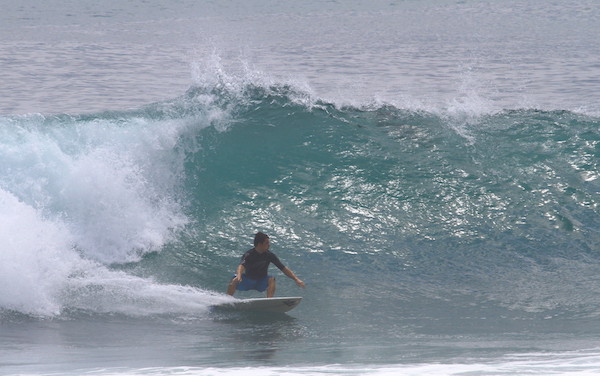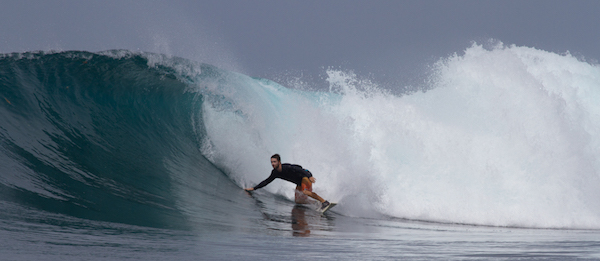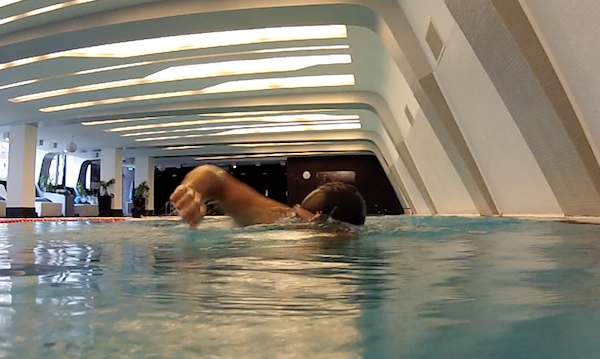The MobilityWOD For Surfers

A shortlist of key Mobility Work for Surfing
What’s the best way to optimize overall fitness for surfing?
It’s a question I’ve been pondering since I took a crash course in human athletic performance at San Francisco CrossFit back in 2013. In about 17 collective months of surfing since–from being obliterated in Hawaii to washing up on various reefs as far away as Chile and Indonesia–I’ve had a lot more time to test the ideas. And more recently, last winter I spent 3 months surfing in the Canary Islands while trying to balance normal life and a somewhat demanding (if amateur) participation in the CrossFit Open.
If you read How I Broke my Body and Fixed it you know I’m a big fan of do-it-yourself physical therapy, but I’ve found very little information specific to surfing. Here are some tips on staying healthy during periods of intense activity in the water, something I originally wrote a few years ago during a month-long stay in the Mentawais Islands.
Feel free to skip directly to the breakdown.
My overall intention was to pull together what I’ve learned over the last few years from the available resources for improving mobility/range of motion/proper movement mechanics. This kind of focused ‘mobility-work’ is typically used in a gym and largely come from the CrossFit community (specifically MobilityWod), but applies to any movement, including surfing. After hundreds of hours of playing around with mobility work in and out of the gym, these are the handful of mobilizations that have the most bang for the buck for surfing.
Since most surfers I know do zero to very little warmup/cooldown–and really only pay lip service to stretching and mobility–adding almost anything here should be an improvement. Many surfers are already familiar with Yoga is great option for maintenance, but the work here is intended to be more specific for problem areas as opposed to a general approach (which is still highly recommended and important).
* A quick note: I’m not a doctor and in fact have no qualifications whatsover, so if you have any real issues make sure you talk to a professional first. The concepts I’m applying here were learned from Kelly Starrett and Roop Sihota at SF Crossfit/MobilityWod.
—
Some people will tell you surfing is not hard on the body.
Or that the best solution (for any kind of life issue, really) is just to surf more. And sure, it’s one of the few sports you’ll see a 50-year age range still participating at a high level. But as you probably know from experience it can still wreak havoc on your shoulders, upper back, and knees.
For anyone out there thinking “not for me” keep in mind we aren’t just talking about injury fixes or prevention, we’re also talking maxing out our potential and optimizing what we’ve got.
I don’t think most people realize how much performance they’re leaving on the table (which applies to anything else as much as surfing). It took me years to understand how I’ve spent a disproportionate amount of time fighting with my own body: a lack of mobility or quality movement that causes everything to be much more difficult than it should be (and sets us up for injury later).
Background: How a Lack of Mobility Affects Surfing (and everything else you do)
Here’s the old analogy: drive a car that’s out of alignment long enough and what happens? The tires wear out. And more specific to fighting with your own mechanics: you burn a ton of energy dealing with misaligned parts. Since surfing = paddling the name of the game is improving paddling efficiency.
The main problems with paddling (which is the same for swimming generally) are:
- Defaulting to a really bad shoulder position, which sets you up for injury.
- Fighting for overhead position, and wasting a ton of energy in the process.
A few years ago it surprised me to discover–despite swimming being commonly recommended as a good option for shoulder rehabilitation–the near impossibility of surfing or swimming with good form. There’s a tendency even at competition-level swimmers for the shoulders hinge forward during the bottom of the swim/surf stroke due to deficiencies in internal rotation.
The less internal rotation capacity you have in the shoulder (most people seem to be missing 50-90% of this range of motion) the harder it’s going to be to keep the shoulder in a good position as you complete the surf stroke.
Where else can this lack of range of motion cause problems?
- Pushups
- Pullups
- Rows
- etc…
In terms of battling for overhead position, the harder it is for you to raise your arms overhead while keeping your rib cage down, the more you’re going to have to arch your back and fight your shoulders to paddle.
The bottom line is that your shoulders seize up or get smoked much faster than they should.
So what happens when you can move without fighting your own body? Well, magic. And a hell of a lot more endurance.
Applying Mobility Work to Real-World Surfing Conditions

Mentawais Islands, March 2014:
Through a lot of real-world testing I’ve seen that a few basic mobility exercises a day–combined with better swimming mechanics–can keep you running for the long-haul.
Add to this some basic work on the engine–3-months of off-season CrossFit training–and I’ve never felt fitter in my life. That said, I’ve always had problems with my left shoulder, and it typically seizes up during periods of prolonged surfing (something like 3-4 hours per day x 4 days). On this trip I had a significant opportunity to see if anything had improved:
The test: Surfing 6-7 hours a day for 10 days straight after 3 months of no surfing and only a few swimming sessions in the pool.
The result: Sleep and nutrition play a major role here, but even after 10 days straight I could have continued without degradation in form or technique.
I was actually blown away by my endurance levels and the lack of wear and tear on my body on this trip.
Here is what I did:
Remember, there are two basic pieces to fixing your own body-
- Fixing mobility issues (tight muscles and joints) and
- Fixing motor control issues (you can’t/ don’t know how to move properly).
I’d suggest tackling both at once.
How to fix or improve basic swimming technique

It’s worth taking a look at Brian Mackenzie’s book Power.Speed.Endurance. To swim/paddle properly your shoulder has to maintain a neutral position vs pitching forward as the hand reaches the end of the stroke. That means actively thinking about keeping the shoulder back in the socket.
Before I initiate a swimming stroke the first thing I do is pull my shoulder back and down. In practice this makes a sort of 2-count stroke:
- Arm comes overhead + Pull shoulder back and down.
- Initiate stroke + Avoid letting the front of the shoulder roll over.
Focusing on this seems to make a major difference in how long I can paddle before my left shoulder seizes up. This takes a bit of mental focus to maintain but like running it turns out this is more complicated than we all initially thought.
Combine a little thought on positioning here with the mobility work below and you should see some results.
Side note on the surf stance:
Standing up quickly on a completely unstable surface complicated and maintaining a good position is not that easy. It’s not often discussed but surfing can cause some unpleasantness in the back knee, because it can put your trailing leg into a continuous wonky collapse (basically the exact opposite of how you want to load the knee) that opens up ample opportunity for tweaks and real injury.
Not only is your knee in a compromised position but there’s a constant rebalancing of weight between legs. It’s crucial to have the ability to instantly re-stabilize the back leg and avoid weighting a really bad position. I’ve noticed that weightlifting has improved this, especially the Olympic lifts like cleans, split jerks (the closest you can get to the surfing position), and snatches–basically anything that requires constantly finding a stable and safe knee position under load.
And don’t forget your trusty Indo balance board. Spending 10 minutes a day on this–focusing on constantly moving in and out of good positions–has made a huge difference for me and immediately applies to movement quality in the water.
The Daily Mobility WOD (Workout of the Day) For Surfers
It takes about 15-20 minutes to complete, but it’s a small investment to keep up with the ongoing wear and tear that’s part of any activity requiring repetitive motion.
You will need a couple props to get this done:
- A cylindrical object to hinge over, e.g.foam roller, double lacrosse balls, Nalgene bottle, baking pin, log, etc.
- Ideally a lacrosse ball (which I always travel with), but you can also use a tennis ball or any other sphere as long as it’s not too soft (wouldn’t go softer than a tennis ball).
- Not required, but you can do amazing things with a jump stretch band if you have one (something like the green band here).
- You can see what this looks like in the travel kit I took to Indonesia.
A couple rules on mobility work before you get started:
- Commit to 2 minutes per mobilization (that means 2 minutes on each shoulder, for example). Nobody pays attention to this, but don’t waste your time by doing something for 10 seconds and wondering why nothing changed.
- Test/Retest. Take a look in a mirror, take a selfie, or have a buddy check out the before after. If you don’t see/feel a change it didn’t work. Most of the time it means you didn’t do it right or long enough. But it can also mean this piece wasn’t the issue and you should work on something else.
- If it feels sketchy it’s probably sketchy/’I’m not a doctor’/’don’t be a dumbass and hurt yourself’ (TM Kelly Starrett).
#1 Thoracic (Upper Back) Extension
If your spine isn’t stacking properly it’s going to be hard to get your shoulder into a good position, and this has the biggest bang for the buck of any overhead mobilization.
As I learned in Kelly’s mobility classes at SF Crossfit, this is upper-body PT 101: fix your thoracic spine (the scaffolding), then go on to the shoulder next.
Basically, all you’re doing is hinging over whatever object you have to open up those vertebral segments. The key is to work systematically through the whole spine and to spend enough time on each spot.
It’s much more effective if you can attack locally with double lacrosse balls first, then globally with something bigger like a foam roller or wall ball.
#2 Freeing the Scapula
This is a favorite and a crowd pleaser. Try one side and see just how much of a difference it makes by holding your arms overhead. What you want to do is work up the inside of the scapula, rib by rib, while completing the across-the-body motion with your hand. Bridge your butt up to add extra pressure. As Kelly says, ‘try to bore that lacrosse ball into your soul’.
#3 Opening up the front of the pec
Most of us have chronically tight tissue here that has shortened over time from a combination of surfing, bench pressing, and working at a desk. Your shoulder has a hard time fighting to get into proper position against this kind of resistance, so break things up by using a lacrosse ball and a doorframe. The key part is swinging your arm up as close to an overhead position as possible.
I’ve been getting a lot of mileage just hanging out here and contracting/relaxing the tissue while digging that lacrosse ball in. Sometimes I also you the door frame to lever my arm against the lacrosse ball. 30 seconds of this can feel like a half-hour massage.
#4 Top of the lats/First Rib Mob.
The lats are a used and abused tissue for surfers, so it helps to grind through this, but this also really opens up my ability to get my arms overhead. It’s a tender spot though, so as Kelly says, just try to avoid puking on the door-frame while you’re working on it.
The key here again is to swing through the full range of motion going past 90 degrees top and bottom.
#5 Battle for internal rotation
This is the most complicated but has a profound affect on shoulder function when done properly, and I’ve been working on this for the last year with slow and steady success. I’ve noticed a lot of shoulder pain was coming from lack of internal rotation, which affects any movement where the hand comes back or down (pushups, rowing, pullups, bench press etc).
The key here is:
Make 100% sure the backs of your shoulders stay on the ground. You have to be totally honest on this one or it’s useless. In order to get into the position I have to bridge my hips about 3 feet into the air to start. Your goal is to start wherever you are and very gently start to work on this. Beware it’s easy to tweak your shoulders if you go to hard right out of the gates, so DO NOT PUSH THIS ONE.
#6 Bonus – The Voodoo Band internal rotation
This requires a bit of special equipment. As of late 2013 I’ve been traveling with a Voodoo band that I bough at San Francisco Crossfit. However, if you have access to a bike shop you can make one out of a spare bike tube (which I ended up doing in the Canaries last winter and it worked great).
Fixing internal rotation is the key to avoiding movement faults in swimming, pushups, dips, and so on. Most of us are operating at 10% capacity here, so a little work can go a long way.
And that’s a wrap
If you have any thoughts about human performance and surfing (or for related sports) I’d love to hear them.
As a followup, it may be about time to write an update to the 2013 How I Broke My Body and Fixed it post, since I’ve learned a lot since. Stay tuned.




